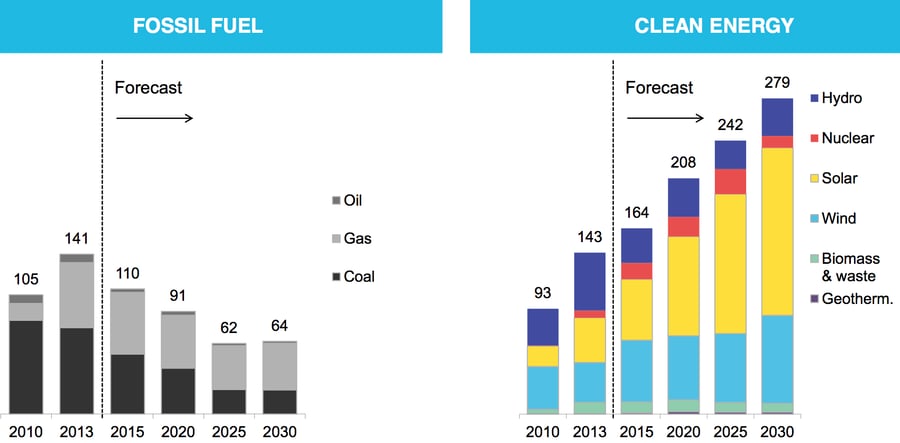
“Fossil Fuels Just Lost the Race Against Renewables,” reads the hyperbolic headline from Tom Randall, writing for Bloomberg Business. “This is the beginning of the end,” the subhead piles on. This report of the death of fossil fuel-powered electricity generation may be exaggerated. But looking closely at Randall’s article, the triumph of advanced energy seems even more of a sure thing.
The source of Randall’s hyperventilation (or the headline writer’s) is Bloomberg New Energy Finance founder Michael Liebreich’s keynote address at the annual BNEF New Energy Summit. There, Liebreich announced that, in new generating capacity installed globally in 2013, “clean” energy – including nuclear power, hydro, solar, wind, geothermal, biomass, and waste – edged out oil, coal, and natural gas, 143 GW to 141 GW. In BNEF’s forecast, the gap grows wider this year and beyond: 164 GW “clean” to 110 GW fossil in 2015; 279 GW “clean” to 64 GW fossil in 2030. (Download the full presentation here.)

Source: Bloomberg New Energy Finance
“The electricity system is shifting to clean,” Liebreich declared. “Despite the change in oil and gas prices there is going to be a substantial buildout of renewable energy that is likely to be an order of magnitude larger than the buildout of coal and gas.”
In fact, the fossil fuel capacity projected to decline sharply over the coming years is mainly coal and oil; natural gas-fired capacity stays relatively steady in the BNEF projection, at roughly 50 GW per year through 2030. (See graph’s from Liebreich’s presentation.) AEE considers natural gas turbines “advanced energy,” as the cleanest and most efficient technology for fossil fuel power generation, as well as all of the sources Liebreich considers “clean.”
But the game changer, Liebreich rightly argues (and Randall correctly reports) is the steadily growing role of wind and solar in the new power mix, today and going forward. Randall also cites a scenario developed by the International Energy Agency under which solar, now accounting for less than 1 percent of electricity generation, could be the single largest power source worldwide by 2050.
The surge in these renewable energy sources is the result of a trend many years in the making. The cost of manufacturing and installing advanced energy technology has been dropping consistently. Solar and wind reaching cost parity with fossil fuels was one of the top 10 advanced energy news stories of 2014. Back then we wrote, “utilities and large energy users in the private sector started to choose advanced energy simply because it was cheaper.”
In October 2013, Xcel Energy submitted plans to the Colorado Public Utility Commission to buy electricity generated solar and wind—simply because it was the cheapest option available. A year later, in October 2014, a Deutsche Bank report concluded solar electricity is on track to be as cheap or cheaper than “average electricity-bill prices in 47 U.S. states.” And overall in 2014, 99 percent of new U.S. electricity capacity was from advanced energy: 53 percent from wind and solar, 43 percent from natural gas.
Just this week, NPR featured a story from the Planet Money team on how solar has gotten “so cheap so fast.” The conclusion? Cheaper panels, faster installation, and innovative financing. The story featured a SolarCity residential installation that took just four hours, compared to several days a few years ago. At the end of the day, the customer expects to save between $70 and $80 a month on his electrical bill.
Fossil fuels may or may not be dying. But the future of electricity generation belongs to advanced energy.
Learn more about the current state of advanced energy in our Advanced Energy Now 2015 Market Report, available for download now.
